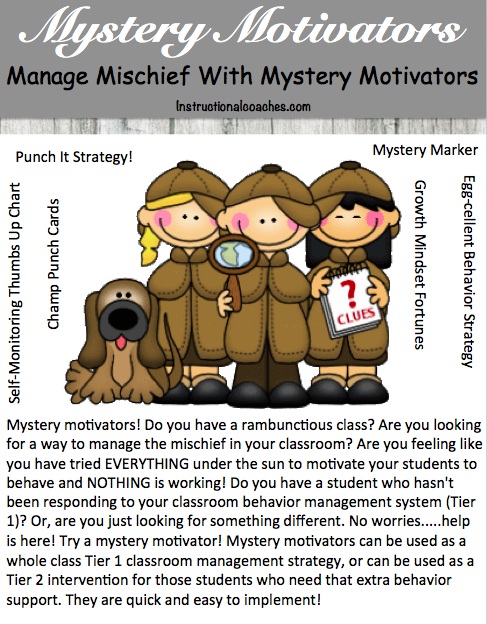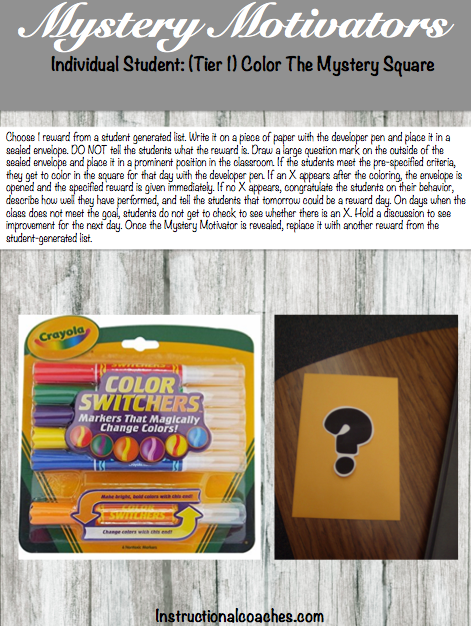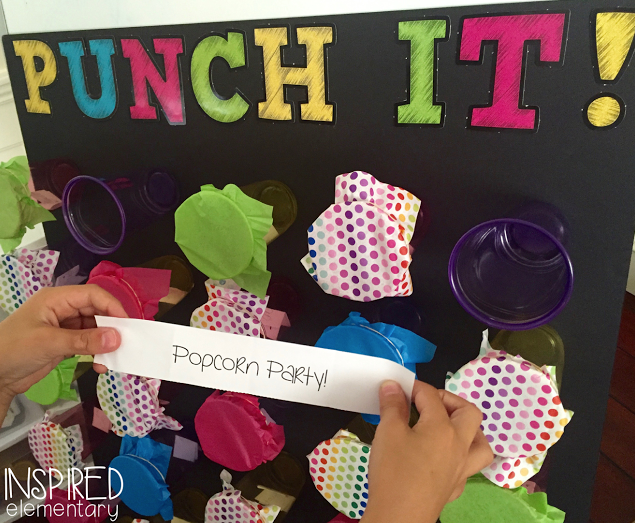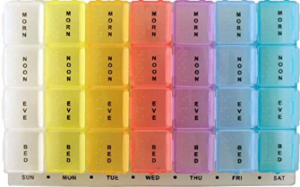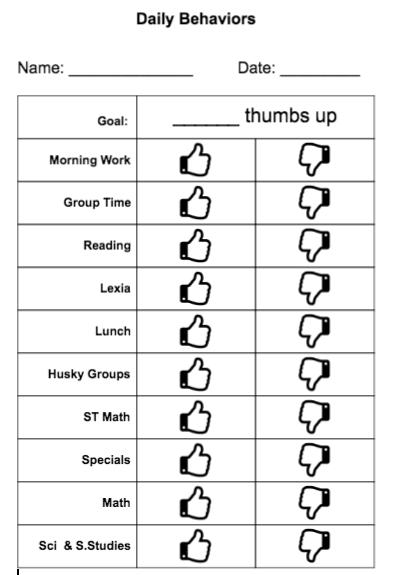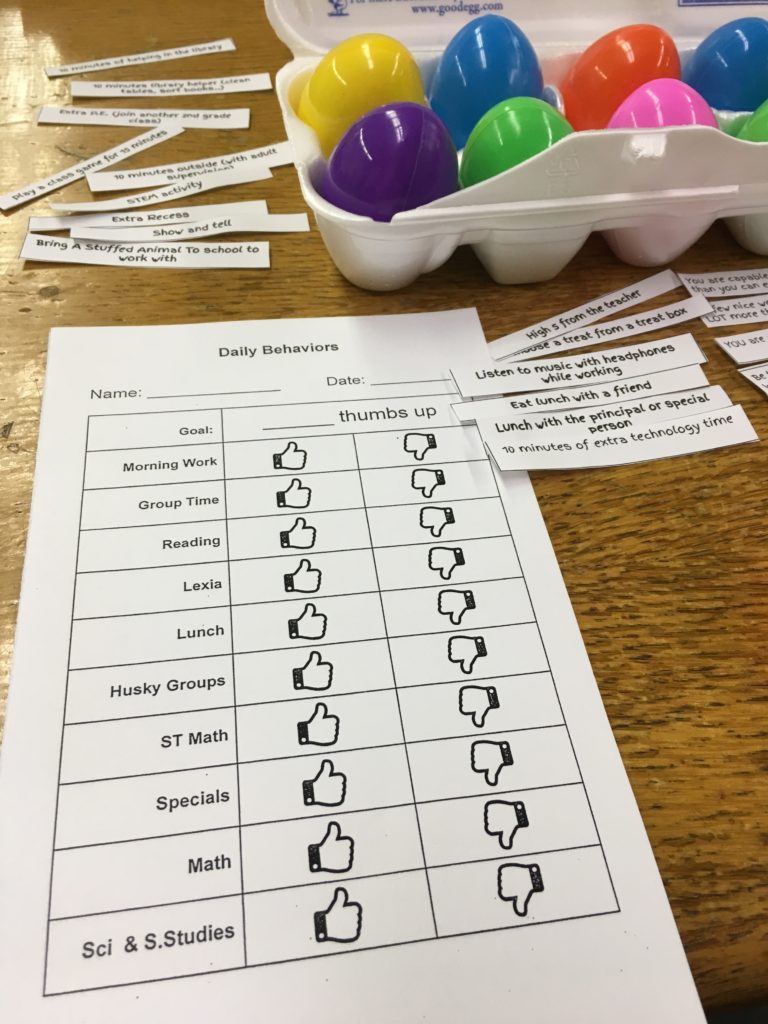Mystery motivators!
Do you have a rambunctious class? Are you looking for a way to manage the mischief in your classroom? Are you feeling like you have tried EVERYTHING under the sun to motivate your students to behave and NOTHING is working! Do you have a student who hasn’t been responding to your classroom behavior management system (Tier 1)? Or, are you just looking for something different. No worries…..help is here! Try a mystery motivator! Mystery motivators can be used as a whole class Tier 1 classroom management strategy or can be used as a Tier 2 intervention for those students who need that extra behavior support. They are quick and easy to implement!
Click Here for my complete list
Positive Behavior Strategy
As an instructional coach, I have been asked by multiple teachers to help with the little ones in their classrooms who just aren’t responding to their classroom management systems. As a former special education teacher, and my experiences working with students with behavior challenges along with working with my own child’s behavior challenges, I have conducted much research. A strategy that I have used in the past and kind of forgot about, is called a mystery motivator! It is an AMAZING strategy that I have had MUCH success with. Mystery motivators build an element of surprise and anticipation with students. This strategy goes along great with Positive Behavior And Supports (PBIS), which our school uses, Trauma-Informed Schools and The Leader In Me program. It is a strategy that focuses on POSITIVE behavior!

What Is A Mystery Motivator?
Students earn MYSTERY prizes or rewards. They literally have NO IDEA what they are working towards until they actually earn it! Rewards are hidden in items such as plastic Easter eggs, pill cases, envelopes, covered cups…. Items are placed into the mystery object. Items can be tangible items, activities, games…. Tangible items like stickers, erasers, gum, tokens, toys….anything you can fit into your motivation container will work. Or, they could be free items like 10 minutes of free time, game time with a friend, lunch in the classroom or high five from the teacher. The smaller items work really well with individual students. If you are using this whole class your rewards can be bigger like an extra recess, class game or treasure hunt. I also throw in some growth mindset quotes and Laffy Taffy type jokes that I like to call “fortunes” (modeled after the fortune cookie of course)!
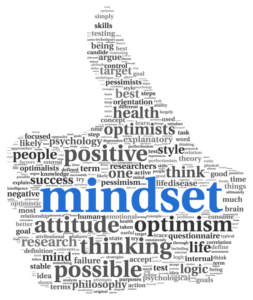
Shouldn’t We EXPECT Student To Comply With Our Rules Without Rewarding Them?
I know!!! I know!!!! Students SHOULD just do what they are told. They NEED to comply!!!! They shouldn’t have to earn things just to get their work done, do what is EXPECTED!!! Well……. do you work for free? I mean really…. think about it…..would you come into work EVERY SINGLE DAY for free (that means absolutely NO PAYCHECK)!!!! I think most of you out there would answer no! I’m right there with you. I LOVE my job, the teachers and students I work with and am passionate about molding young minds, but I would not, could not work for no $$$$$. I have used mystery motivators with quite a few of our “high fliers”. They work every time!!!! Mystery motivators are a great Tier 2 strategy!
How Do I Start With A Mystery Motivator?
Individual Student or Whole Class? The key to using a mystery motivator is to first figure out HOW you want to use it and WHO you are using it with. Are you going to use it whole class or with an individual student or both?
Survey Your Students: You will need to survey your students or have them come up with rewards they would like to earn. This is an important step. You want to make sure that students are earning preferred items and activities, otherwise, the motivation part won’t work.
Brainstorm Motivators: I usually ask my whole class WHAT they would like to work towards earning. For individual students, I give them a list of items (usually smaller items) they can choose from and ask them if there is anything they would like to work towards that is not on my list. Check out my rewards list. If you are planning on using mystery motivators with your whole class and an individual student, make sure you create a list with the whole class and a specific list with the individual student. I cut this list up and use the slips of paper in my Easter eggs along with a growth mindset “fortune”. 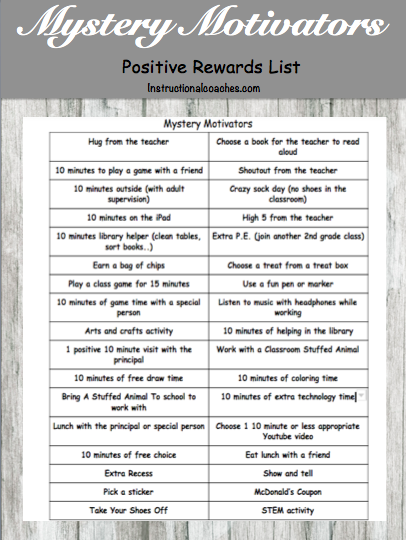
Set Positive Behaviors:
Students need to know how they will earn the mystery reward. What are you going to be looking for? Be specific with your positive behavior expectations! This could and SHOULD follow your classroom rules and behavior expectations. Make sure to keep it POSITIVE. Create a visual list and post it clearly in your classroom. Remember, this is a motivation tool, NOT a punishment tool!
Set Up Your Tools: Get A Full List Of My Tools Here!
I have used a few different tools for my mystery motivators. I have used notecards or popsicle sticks in a manilla envelope (color the mystery square-great for all ages), plastic easter eggs (Egg-cellent behavior), covered cups (punch it picture-great for older students) and pill cases (yes the kind you keep medicine in)! Be creative! You can really use anything that you can HIDE the rewards in. My ABSOLUTELY favorite tool for (younger students) that I have used is plastic Easter eggs. They are fun to open, cheap and you can’t see through them. I keep them in an egg carton when I use them with individual students and a basket when using them whole class. These are very affordable and reusable! I like the Punch It Cup Board for older students (they like it too)! Check out inspiredelemenatry.com for ideas and directions on how to make this tool.
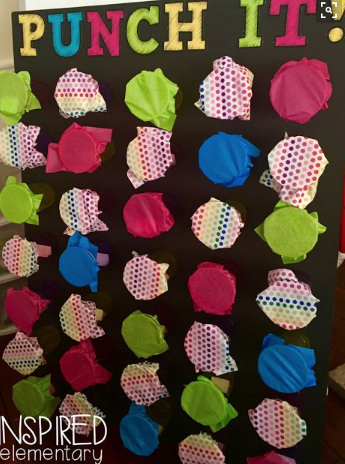
Set Your Timeline and Goals:
Will your students earn a class reward once a week, once a month, daily? It really depends on the behavior needs of your class and the age of your students. Younger students will need to earn a reward on a more short-term basis than older students could. If you have a really wild class, you will need a more short-term reward (even for older students). Like any management system, you will need to overdo it a bit in the beginning by setting shorter goals then build up to a long term goal. Students with more severe behaviors will probably need very short term goals. It’s immensely important to have students help set the goals! Goal setting is a great way for students to hold themselves accountable!
Whole-Class Mystery Motivators (Tier 1)
Mystery motivators really work well with a whole class. Grow a growth mindset with your mystery motivator!
Egg-cellent Behavior:
Place a growth mindset saying inside each egg (or another mystery item). For every egg earned, students will open and read the saying (all except for the “special egg” holding the mystery prize). Take a few minutes as a class to discuss what the growth mindset saying means. The goal is to fill the basket. This will help those students who just can’t help themselves or the ones who just want to sabotage or curious students. Remember, the goal is to keep the reward a mystery until the goal is met. Mystery motivators can be used as THE classroom behavior management system, or to enhance your current system. This could work with most systems. Here are a few I have used mystery motivators with to enhance what I already had in place.

Easter eggs filled with Growth Mindset messages or “fortunes” are PERFECT to use in your morning meeting or social skills training. I have placed role-playing scenarios or a what would you do type social skills situation in the eggs for our morning meeting. These lead to great conversations where students can make connections, reflect on a time that happened to them or someone they know and helps prepare them if that situation would arise in their lives. I usually choose topics that I saw we needed to discuss. In my 3rd grade class, we covered topics like telling vs. tattling, bullying, sharing, disagreements…..What a GREAT way to start the day!
Punch IT!
How it works: Students earn letters (1 at a time) on the board every time the class is “caught” following classroom rules & procedures. Compliment them and write the letter “P” on the board. The next time you “catch” your class with positive behavior, write the letter “U” on the board.. Once the phrase PUNCH IT! with the exclamation mark is written on the board a student gets to “punch the cup”. Use a random student picking tool to determine the student. Inside the cups are class prizes and growth mindset quotes along with a reward of some type. Check out inspiredelemenatry.com for ideas and directions on how to make this tool. This blog is AMAZING!!!! Erin really does a great job explaining how to use this strategy along with tons of other cool posts:) I adapted this idea to fit my own classroom.
Mystery Marker:
If the students meet the pre-specified criteria, they get to color in the square for that day with the developer pen. If an X appears after the coloring, the envelope is opened and the specified reward is given immediately. If no X appears, congratulate the students on their behavior, describe how well they have performed, and tell the students that tomorrow could be a reward day. On days when the class does not meet the goal, students do not get to check to see whether there is an X. Hold a discussion to see improvement for the next day and set goals. Once the Mystery Motivator is revealed, replace it with another reward from the student-generated list.

Get Your Mystery Markers Here!
Mystery Boxes: (Tier 2 ONLY)
This strategy is designed for those students who require a more instantaneous gratification. This works really well with students who benefit from a reward for each task they complete appropriately. To use the pill case as the mystery motivator (yes, it’s a real pill case) place a small reward in each box (NO PILLS PLEASE). I usually use items like small erasers, candies, crackers….. whatever will motivate your student. I also place a growth mindset fortune in each box that the student will need to read (or have read to them) and discuss with an adult.
You can also use the mystery motivators from the interest inventory along with a tangible reward, or by itself. It really depends on the level of motivation your student needs. Your timeframe could also change according to your student’s needs. They could earn their reward after completing one assignment, or after the entire reading block. You will need to decide what is best for your student and try different time frames. You will want to overdo it at first and give rewards often, then once it starts working, expand your time frame for those students exhibiting the more extreme behaviors.
My students have been earning one mystery box for each thumbs up earned. They don’t get the reward in the box if they don’t earn their thumbs up on their chart. It is extremely important that they get their reward as soon as they earn it! It also needs to stay a mystery. I tell my students that if they peek, they don’t get the reward. I cover the top of the box with their pictures (or words for older students) of their task or schedule.
Mystery Motivator With A Clip Chart:
I have used it with a clip chart. I set a goal with my class that if all of my students (the goal depends on the type of class you have) could get to a certain color on the clip chart they could earn a mystery motivator. In using plastic eggs, I used the same concept as the fill the jar concept except we filled a basket. Once the basket was filled, the class could earn their mystery reward (which I placed in the golden egg). The golden egg couldn’t be opened until the basket was full. This reward usually took my class about a month to earn after we had it up and running. I started with a short-term goal to start with (1 week).

When our basket was full, we had a class Easter egg hunt. With the teacher in me, this of course was not a FREE hunt (but the students didn’t know it until the day of the hunt). I wrote math facts (we were learning multiplication facts) on the outside of each egg. To differentiate for my students’ needs I wrote some easier facts (like the 0 and 1 facts) along with some double-digit facts (34×20) to challenge the students who had already mastered their facts. They were instructed to ONLY pick up the egg if they knew they could answer the problem (or they wouldn’t get what was inside).
I have also used sight words. I had enough eggs for each one of my 27 students to pick up 7 eggs. I gave them each an egg carton, blew my whistle and off they went until we couldn’t find any more eggs. Just make sure to count the eggs before you hide them:) I hid a few extra just in case some weren’t found. Eggs were found by random recess students for days after out hunt (which caused a few problems with other teachers), oops.
Mystery Motivator With A Tally System Or Mystery Word:
I am currently using the mystery motivators in conjunction with the mystery word system in a 2nd-grade classroom. Use the same concept above but students earn a mystery motivator for each tally they get as a class or the number of letters revealed in the mystery word. You could also use this with a red, yellow, green flip a card system (I really don’t recommend this approach -as it does not focus on POSITIVE behavior), this is just my own personal opinion! But, you could have your students who have green cards at the end of the day earn an egg (or whatever other creative mystery you use) for your class basket. I have also used mystery motivators with my classroom economy system. Students could buy Easter eggs with their “classroom cash” to fill our basket.
With all of the systems I have mentioned above, I would also randomly place a “free” egg in the basket, just because and tell my students how AMAZING they were:)
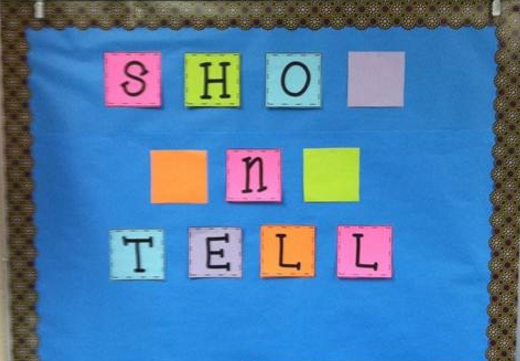
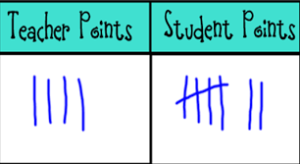
Mystery Motivators With Individual Students (Tier 2):
Tier 2 Targeted Intervention And Supports (MTSS, RTI):
Tier 2 doesn’t replace tier 1 supports, rather, it’s in addition to. In order to determine whether a student qualifies for tier 2 supports you will need to look at a few things such as office referrals, screenings, teacher nominations and formative assessments. Students are compared to their peers. Mystery motivators are a GREAT tool to use with students who need super short term motivation!
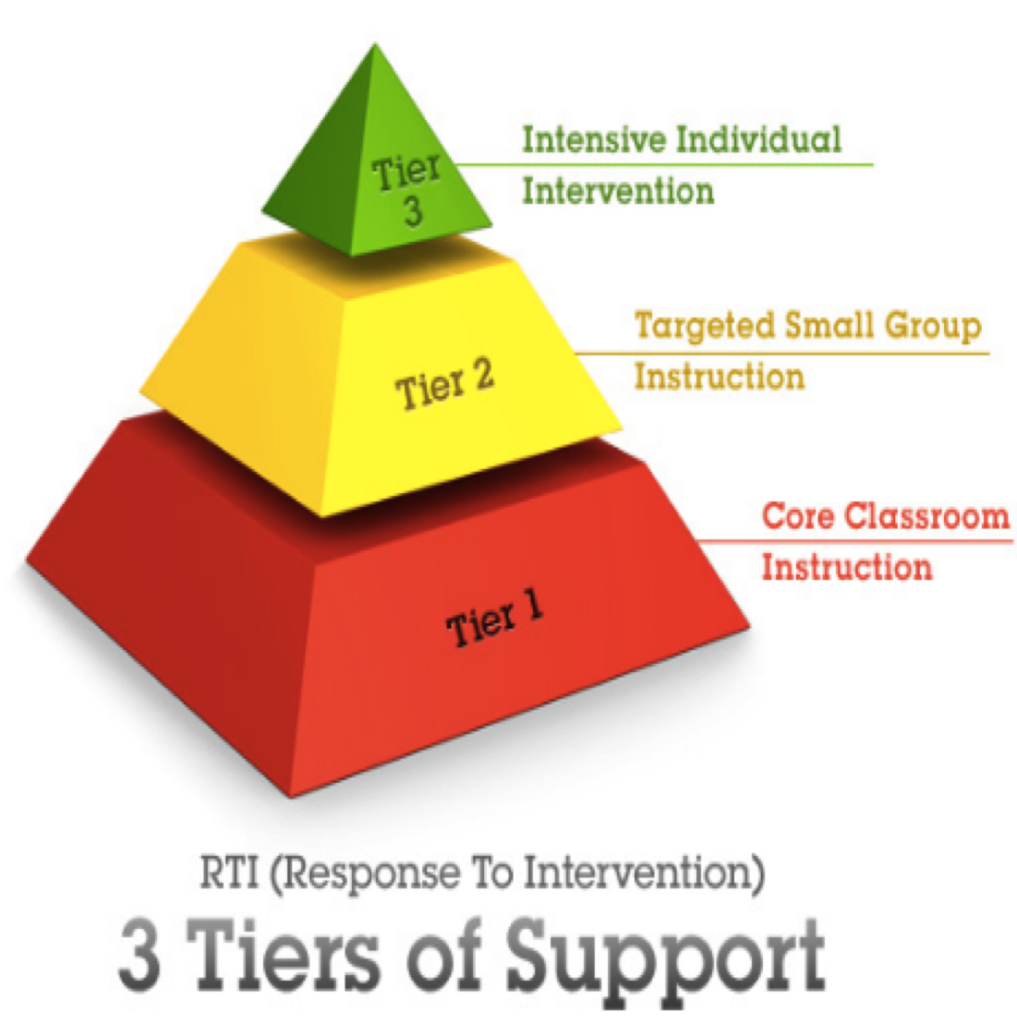
1. Tier 1 Core Classroom Instruction: You need to first make sure that your tier 1 (whole class management system) is strong before even considering conducting a tier 2 intervention! This is a VITAL step! Take a close look at your class rules, procedures and expectations. Contrary to what some teachers think, procedures need to be taught, re-taught and practiced consistently. They need to be clearly stated, displayed and referred back to often (like every time you use a procedure).
I have been in sssssoooooo many classrooms where rules and procedures were taught in the first week of school, but NEVER re-taught, followed through with consistently or referred back to! Sometimes this is all we need to do in order to get the mischief under control. I always tell the teachers to start with going back to the basics. The point of teaching procedures is to get the students automatic at following them. If you have to, overdo it at first. I mean really, this will eventually annoy your students sssssooooo much that they will start holding themselves and each other accountable for following your procedures. It will also communicate to them that you are serious about the expectation that all students follow the classroom procedure.
Check out my Tier 1 supports here.
2. Conduct the ABC’s Of Problem Identification: Using data to identify and define problem behaviors (This is where an instructional coach or guidance counselor can help identify the ABC’s of behavior identification). Problem Analysis: Using data to hypothesize why the problem behavior identified is occurring. Intervention Design: Developing and implementing evidence-based behavioral supports and interventions that match the hypothesis. Universal strategies, replacement behavior. Response to Instruction/Intervention: Using data to determine the effectiveness of the supports to decide next steps. A crucial part of determining the reason for an undesirable behavior is observing the context in which the behavior occurs, including all antecedents and consequences. Use the ABC’s of behavior identification:
A- Antecedents: What is happening right before the behavior occurs?
B- Behavior: What the student does, says or doesn’t do. C-Consequence: What happens after the behavior occurs?
3. Select Motivators: It’s important that you gather a list of motivators that the student would like to work towards earning. There are TONS of ready-made lists out there, but they had items that weren’t realistic/possible for my teacher to use, so, we created our own list of possible motivators. I always make sure to also ask the student if there is anything missing from the list that they would like to earn. Remember, this is the MOTIVATION part, so it is extremely IMPORTANT to have the student choose what they want to earn.
4. Develop A Plan & Goal: Identify positive behaviors, develop specific goals including a timeline (how often they will be earning the motivator) and figure out what tools you will be using (eggs, sticks, envelopes, pill case..) I would recommend using a mystery motivator along with a self-monitoring tool. The student needs to monitor their own behavior in order to increase their self-regulation.
This is the self-monitoring chart I am using with a 2nd-grade student. He earns one mystery motivator (Easter egg) for each thumbs up. He gets to pick one egg out of his egg carton immediately after each section. His eggs contain a motivation slip, small treat (like crackers, stickers, candy) and a growth mindset “fortune”. We also use this self-monitoring chart to set goals during his check-in/check- out. If he meets his goal for the day (we started at 6 out of the 12 eggs) he gets to pick a McDonald’s coupon.
We literally started out with a baseline of 0 out of 12. We are working our way up to 12/12 of course. I actually ended up breaking up his morning and his afternoon. He could earn 6 mystery motivators in the morning and 6 in the afternoon with a goal of 3 eggs in the morning and 3 in the afternoon. He came up with all of the motivators, he just doesn’t get them unless he earns the thumbs up. Click here for your free copy.
5. Communicate With The Student: Sit down privately with your student and communicate the new plan. Make sure that you communicate this as a POSITIVE thing!! Many students with mischievous behavior are VERY smart and can usually figure out that they are the only one in class on this plan. Some students don’t want to be singled out with an individualized plan. This is where we started the mystery motivator with the whole class as well (see above).
6. BE CONSISTENT: Follow through with the plan with fidelity. Use formative assessments (daily charts) to gauge whether it is working. Make sure that you praise the student regularly! Remember, POSITIVE reinforcement breeds positive behavior!
